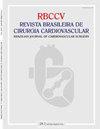The Need for Creating a Unified Knowledge of Cardiovascular Diseases in Latin America
IF 1.2
4区 医学
Q4 CARDIAC & CARDIOVASCULAR SYSTEMS
Revista Brasileira De Cirurgia Cardiovascular
Pub Date : 2022-05-23
DOI:10.21470/1678-9741-2022-0954
引用次数: 1
Abstract
Cardiovascular diseases (CVDs) have persistently been the principal cause of disease burden and mortality throughout the world as well as in Latin America (LATAM)[1,2]. Congruently, as CVDs continue to grow, the research production in this discipline has followed the same trend; global CVD publications have been increasing in the last decades[3,4]. However, as with other health-related topics, disparities in the quantity of research exist when comparing lowand middle-income countries with high-income nations[3,4]. Despite the simultaneous increasing trend in CVD research output in LATAM, this region is clearly behind in terms of publications when compared to North America or Europe. A bibliometric analysis of CVD papers in PubMed® identified that 4% of them were from LATAM, as opposed to 40% from European countries[5]. Even between Latin American countries, disparities also exist, with Argentina, Brazil, and Mexico being the most represented countries in published research in the region[5,6]. As a reader, when assessing collaborative or pooled studies such as clinical trials or systematic reviews, there seems to be a lower representation of the Latin American population, publications, and/or journals. This could possibly be explained due to language barriers, as Spanish or Portuguese publications are excluded in many cases from systematic reviews, or due to the lack of indexation of many Latin American medical journals in major international databases such as PubMed®/MEDLINE®[7,8]. In our recent experience, we identified that information about the Latin American population’s characteristics of infective endocarditis (IE) was lacking. Therefore, our approach was to conduct a systematic review including the two major international databases, as well as two regional Latin American databases. We identified and described compiled information on the major characteristics of IE that hopefully will be useful, or at least be a starting point for clinicians, researchers, and local guidelines[9]. Efforts to develop a unified knowledge, via systematic reviews, have also been conducted by other authors in the field of CVDs in LATAM[10,11]. For instance, Ciapponi et al.[10] DOI: 10.21470/1678-9741-2022-0954建立拉丁美洲心血管疾病统一知识的必要性
心血管疾病(CVD)一直是世界各地以及拉丁美洲(LATAM)疾病负担和死亡率的主要原因[1,2]。值得注意的是,随着心血管疾病的持续增长,该学科的研究成果也遵循了同样的趋势;在过去的几十年里,全球CVD出版物一直在增加[3,4]。然而,与其他健康相关主题一样,在比较中低收入国家与高收入国家时,研究数量存在差异[3,4]。尽管LATAM的CVD研究产出同时呈增长趋势,但与北美或欧洲相比,该地区的出版物明显落后。PubMed®对CVD论文的文献计量分析表明,其中4%来自LATAM,而欧洲国家的这一比例为40%[5]。即使在拉丁美洲国家之间,也存在差异,阿根廷、巴西和墨西哥是该地区发表研究中代表性最强的国家[5,6]。作为读者,在评估合作或联合研究(如临床试验或系统综述)时,拉丁美洲人群、出版物和/或期刊的代表性似乎较低。这可能是由于语言障碍,因为西班牙语或葡萄牙语出版物在许多情况下被排除在系统综述之外,或者由于PubMed®/MEDLINE®等主要国际数据库中许多拉丁美洲医学期刊缺乏索引[7,8]。根据我们最近的经验,我们发现缺乏关于拉丁美洲人群感染性心内膜炎(IE)特征的信息。因此,我们的做法是进行系统审查,包括两个主要的国际数据库以及两个拉丁美洲区域数据库。我们确定并描述了有关IE主要特征的汇编信息,这些信息有望有用,或者至少是临床医生、研究人员和当地指南的起点[9]。LATAM心血管疾病领域的其他作者也通过系统综述努力开发统一的知识[10,11]。例如,Ciapponi等人[10]DOI:10.21470/1678-9741-2022-0954
本文章由计算机程序翻译,如有差异,请以英文原文为准。
求助全文
约1分钟内获得全文
求助全文
来源期刊

Revista Brasileira De Cirurgia Cardiovascular
CARDIAC & CARDIOVASCULAR SYSTEMS-SURGERY
CiteScore
2.10
自引率
0.00%
发文量
176
审稿时长
20 weeks
期刊介绍:
Brazilian Journal of Cardiovascular Surgery (BJCVS) is the official journal of the Brazilian Society of Cardiovascular Surgery (SBCCV). BJCVS is a bimonthly, peer-reviewed scientific journal, with regular circulation since 1986.
BJCVS aims to record the scientific and innovation production in cardiovascular surgery and promote study, improvement and professional updating in the specialty. It has significant impact on cardiovascular surgery practice and related areas.
 求助内容:
求助内容: 应助结果提醒方式:
应助结果提醒方式:


